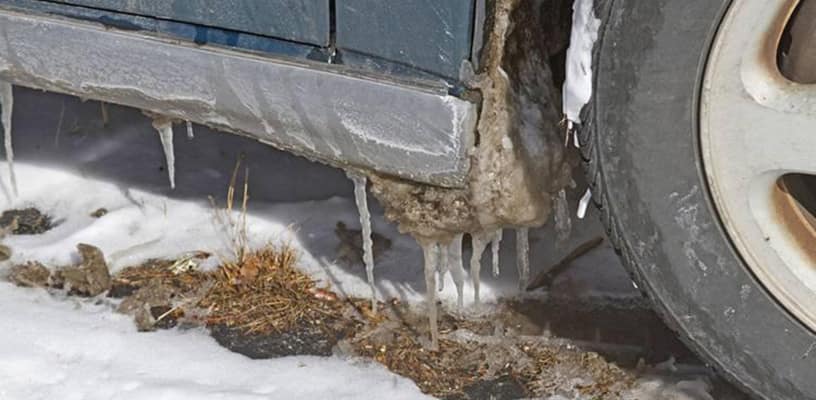Road salt creates a uniquely destructive environment for vehicles, combining chemical aggression with moisture to accelerate corrosion in ways that can quickly compromise both appearance and structural integrity. Understanding how salt attacks different vehicle materials helps owners implement effective protection strategies that prevent costly damage while maintaining vehicle value.
Understanding Salt’s Destructive Nature
Road salt works through an electrochemical process that makes it particularly damaging to vehicles. When salt dissolves in moisture, it creates an electrolyte that accelerates the natural corrosion process of metals. Think of it as creating thousands of tiny batteries across your vehicle’s surface, each one slowly consuming metal through galvanic corrosion. This process continues even after visible salt disappears, making prevention particularly crucial.
Modern vehicles face additional challenges from new de-icing chemicals that municipalities often mix with traditional road salt. These chemicals can penetrate protective coatings more effectively than traditional salt, creating new pathways for corrosion to begin. Understanding these threats helps develop comprehensive protection strategies that address both immediate and long-term damage risks.
Professional-Grade Protection Methods
Effective salt protection begins with proper preparation before exposure occurs. Professional-grade undercoating products create physical barriers that prevent salt from reaching vulnerable metal surfaces. Modern ceramic coatings can provide superior protection compared to traditional undercoating, forming molecular bonds with metal surfaces that resist salt penetration while remaining flexible enough to prevent cracking under road stress.
Consider that different areas of your vehicle require different protection approaches. Wheel wells and rocker panels often suffer first from salt damage due to direct spray exposure. Professional-grade protective films applied to these areas can provide additional protection while remaining nearly invisible. These films prove particularly valuable for preserving painted surfaces that receive regular salt spray.
Preservation Through Regular Maintenance
Regular washing plays a crucial role in salt damage prevention, but technique matters significantly. Professional washing methods focus on thorough undercarriage cleaning using specialized equipment that reaches hidden areas where salt accumulates. High-pressure washing helps remove salt deposits, but proper technique proves essential to prevent forcing water into areas where it might become trapped.
Consider establishing a regular washing schedule during salt season rather than waiting for visible salt accumulation. Professional detailers recommend washing at least weekly when roads are treated, focusing particular attention on undercarriage areas and wheel wells where salt concentration tends to be highest. Remember that washing in freezing temperatures requires special consideration to prevent door and lock freezing.

Critical Areas Requiring Special Attention
Certain vehicle areas prove particularly vulnerable to salt damage and require specific protection strategies. Frame rails and suspension mounting points often trap salt-laden moisture, creating perfect conditions for accelerated corrosion. Professional inspection of these areas helps identify developing problems before they become serious. Consider applying additional protection to these critical structural components.
Brake lines and fuel lines running along the undercarriage deserve particular attention. These components often suffer hidden corrosion that might not become apparent until failure occurs. Professional inspection can identify developing problems while they remain repairable. Consider replacing vulnerable steel lines with corrosion-resistant materials in areas with heavy salt exposure.
Paint and Finish Protection
While structural protection remains crucial, protecting your vehicle’s finish from salt damage helps maintain both appearance and value. Professional-grade paint sealants and ceramic coatings create lasting barriers against salt damage while making regular cleaning more effective. These coatings prove particularly valuable for protecting vulnerable areas like lower body panels and door edges where salt tends to accumulate.
Remember that paint protection requires proper preparation to provide lasting benefits. Professional application includes thorough paint decontamination and correction before applying protective coatings. This preparation ensures maximum coating adhesion and effectiveness while addressing any existing paint damage that might allow salt penetration.
Electronic System Protection
Modern vehicles contain numerous electronic systems vulnerable to salt-related corrosion. Professional protection includes treating electrical connections with dielectric grease to prevent salt intrusion while maintaining proper conductivity. Pay particular attention to ground connections and sensor wiring that might be exposed to salt spray. Consider that electronic problems often develop gradually, making regular inspection particularly important.
Remember that modern safety systems rely on numerous sensors mounted in areas exposed to salt spray. Professional inspection of these components helps identify developing problems before they affect system operation. Consider applying additional protection to sensor mounting areas and connections to prevent salt-related failures.
Interior Protection Strategies
Salt inevitably enters vehicle interiors on shoes and clothing, potentially causing damage to floor pans and interior components. Professional-grade floor liners provide superior protection compared to standard floor mats, containing moisture and salt while preventing contact with carpet and metal surfaces. Consider applying protective treatments to carpet and upholstery to prevent salt staining and deterioration.
Regular interior cleaning proves essential during salt season, focusing on removing salt residue before it can cause lasting damage. Professional cleaning methods include thorough extraction of salt from carpet fibers and careful attention to areas where salt might accumulate unnoticed. Remember that interior corrosion often begins from salt trapped beneath carpet and insulation.
Prevention Through Proactive Measures
Preventing salt damage requires understanding both immediate and long-term protection needs. Professional inspection helps identify vulnerable areas requiring additional protection while documenting existing condition for future reference. Consider maintaining detailed records of protection measures and regular inspections to track effectiveness and identify developing problems early.
Remember that salt protection represents an ongoing process rather than a one-time treatment. Regular maintenance and inspection help ensure protection remains effective while identifying any areas requiring additional attention. Professional evaluation helps develop effective protection strategies tailored to your specific vehicle and operating environment.
















Add Comment